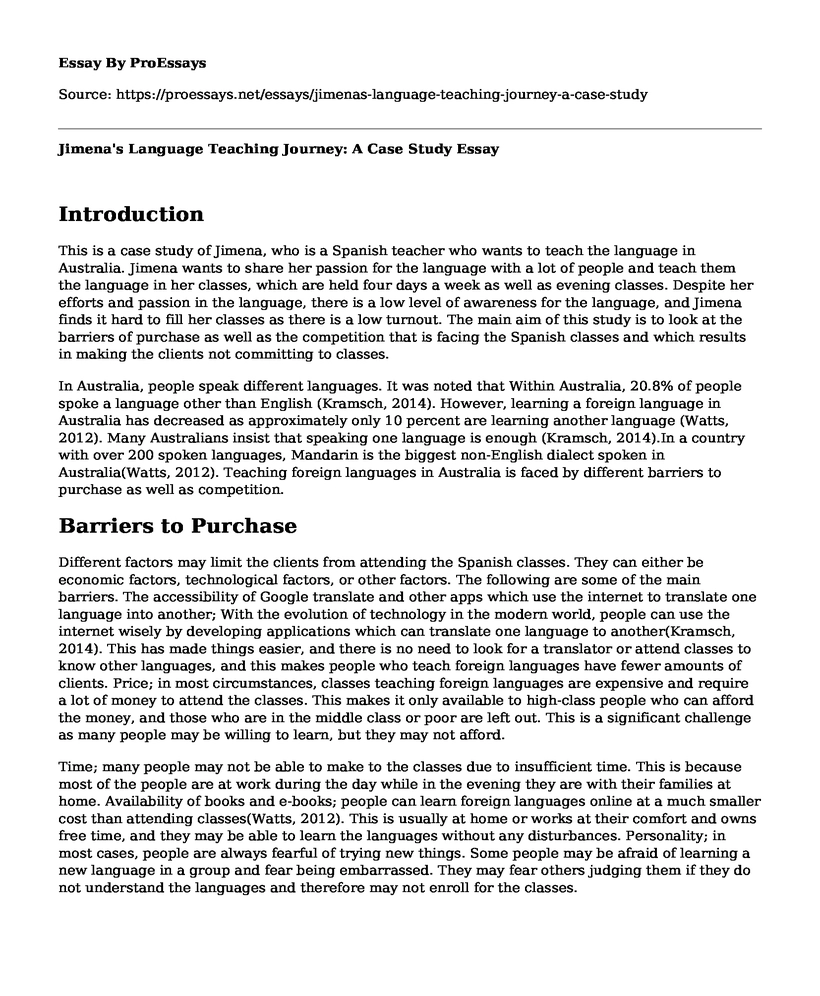Introduction
This is a case study of Jimena, who is a Spanish teacher who wants to teach the language in Australia. Jimena wants to share her passion for the language with a lot of people and teach them the language in her classes, which are held four days a week as well as evening classes. Despite her efforts and passion in the language, there is a low level of awareness for the language, and Jimena finds it hard to fill her classes as there is a low turnout. The main aim of this study is to look at the barriers of purchase as well as the competition that is facing the Spanish classes and which results in making the clients not committing to classes.
In Australia, people speak different languages. It was noted that Within Australia, 20.8% of people spoke a language other than English (Kramsch, 2014). However, learning a foreign language in Australia has decreased as approximately only 10 percent are learning another language (Watts, 2012). Many Australians insist that speaking one language is enough (Kramsch, 2014).In a country with over 200 spoken languages, Mandarin is the biggest non-English dialect spoken in Australia(Watts, 2012). Teaching foreign languages in Australia is faced by different barriers to purchase as well as competition.
Barriers to Purchase
Different factors may limit the clients from attending the Spanish classes. They can either be economic factors, technological factors, or other factors. The following are some of the main barriers. The accessibility of Google translate and other apps which use the internet to translate one language into another; With the evolution of technology in the modern world, people can use the internet wisely by developing applications which can translate one language to another(Kramsch, 2014). This has made things easier, and there is no need to look for a translator or attend classes to know other languages, and this makes people who teach foreign languages have fewer amounts of clients. Price; in most circumstances, classes teaching foreign languages are expensive and require a lot of money to attend the classes. This makes it only available to high-class people who can afford the money, and those who are in the middle class or poor are left out. This is a significant challenge as many people may be willing to learn, but they may not afford.
Time; many people may not be able to make to the classes due to insufficient time. This is because most of the people are at work during the day while in the evening they are with their families at home. Availability of books and e-books; people can learn foreign languages online at a much smaller cost than attending classes(Watts, 2012). This is usually at home or works at their comfort and owns free time, and they may be able to learn the languages without any disturbances. Personality; in most cases, people are always fearful of trying new things. Some people may be afraid of learning a new language in a group and fear being embarrassed. They may fear others judging them if they do not understand the languages and therefore may not enroll for the classes.
Competition
Foreign languages also face competition which is one of the main reasons why the classes are not full of students. This competition may either be direct or indirect. Direct competition is competition which one comes into contact with directly as they are chasing the same market or clients. On the other hand, indirect competition can be defined as the competition of services which may substitute each other although they do not sell the same products.
Direct competition: Spanish classes may face direct competition from other languages such as English and French. This is because English is the most spoken language, and therefore many people opt for English classes because they are well conversant in them(Watts, 2012). French courses may also be offering the same opportunities to people to learn new languages, and this is therefore direct competition as people may be divided on which language to learn, and consequently, they split to different languages. Another direct competition comes from the first language of people. The language that people have known since they were born poses a high competition as a lot of people are not ready to leave it.
Indirect competition: Spanish classes may also face indirect competition. The indirect competition may come from other sources such as social media or the internet. The social media or the internet may advertise or recommend people to learn other languages other than Spanish, and this promotes other languages more than Spanish(Kramsch, 2014). This may be considered as indirect competition as other languages are promoted while the Spanish classes are not. Another case of indirect competition may be the case that people speak different languages more when communicating other than Spanish. If people do not talk about the language that they learn even if it is new, it does not become promoted, and therefore it faces more competition from languages that are frequently used.
References
Kramsch, C. (2014). Teaching Foreign Languages in an Era of Globalization: Introduction. The Modern Language Journal, 98(1), 296-311. doi:10.1111/j.1540-4781.2014.12057.x
Watts, C. (2012). Living Languages: An Integrated Approach to Teaching Foreign Languages in Primary Schools. doi:10.4324/9780203809396
Cite this page
Jimena's Language Teaching Journey: A Case Study. (2023, Feb 12). Retrieved from https://proessays.net/essays/jimenas-language-teaching-journey-a-case-study
If you are the original author of this essay and no longer wish to have it published on the ProEssays website, please click below to request its removal:
- Paper Example on Positive Benefits of Family Engagement in the Early Childhood Program
- Essay Sample on Teaching Against Globalization and the New Imperialism: Toward a Revolutionary Pedagogy
- Comparative Essay between Childhood and Adulthood
- Gender Inequality: Critical Thinking Assignment
- Essay on School Enrollment Booms, But Challenges Abound for Programs
- Free Paper on Becoming an Ideal Teacher: Igniting Creativity and Imagination
- Essay Example on Children's Vaccination







